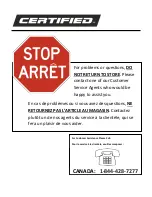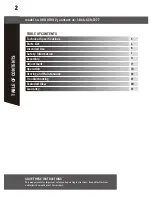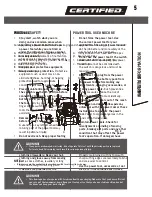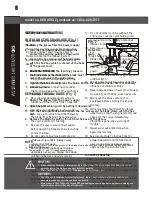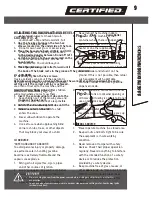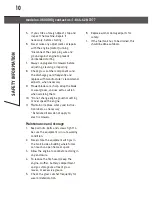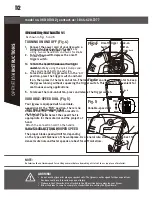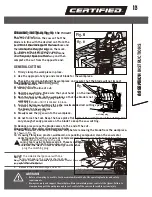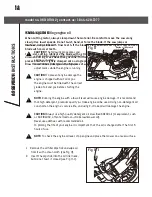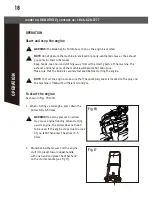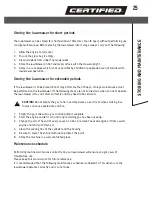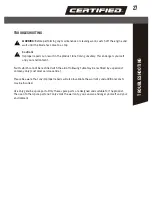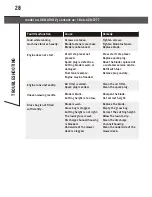
11
OPERATION IN
STRU
CTIONS
STRAIGHT CUTTING (Fig. 6)
Mark the cut. Position the saw so that the
blade is in line with the desired cut. Mark the
position of the side edge of the saw base and
then clamp the straight edge on the mark,
parallel to the cut. Make the cut from one
direction only. Never cut halfway and then
complete the cut from the opposite end.
GENERAL CUTTING
1. Firmly clamp the workpiece in place.
2. Use the appropriate type and size of blade for the workpiece.
3. Check the clearance behind the workpiece and assure that the blade will not impact
another surface.
4. Clearly mark the line of cut.
5. Hold the saw firmly. Make sure that your hand is on the insulated gripping areas only.
6. Rest the base plate on the workpiece so that the blade is not in contact with the
workpiece
7. Turn on the jigsaw and bring it to the maximum desired cutting speed before applying
the blade to the workpiece.
8. Slowly move the jig saw into the workpiece.
9. Do not force the tool. Keep the base plate flat against the workpiece while cutting. Use
only enough steady pressure on the blade to keep the saw cutting.
10. Reduce pressure as the blade comes to the end of the cut.
11. Allow the saw to come to a complete stop before removing the blade from the workpiece.
12. If sawing fibreglass, plaster, wallboard, or spackling compound, clean the saw motor
vents frequently with a vacuum or compressed air. Always wear safety goggles when
cleaning tools using compressed air. These materials are highly abrasive and may
accelerate the wear on motor bearings and brushes.
Fig. 6
WARNING!
• Before attempting to use this tool, become familiar with all of its operating features and safety
requirements.
• Always securely and support the workpiece. Always maintain proper control of the jigsaw. Failure to
clamp and support the workpiece and loss of control of the saw could result in serious injury.
NOTE:
Always apply a steady, firm, downward pressure on the front of the saw as you cut. This will keep the saw blade from
jumping out of the workpiece.
Safety instructions
Safe Practices for Pedestrian-controlled
Mowers
This cutting machine is capable of amputat-
ing hands and feet and throwing objects.
Failure to observe the following safety
instructions could result in serious injury or
death.
I. GENERAL OPERATION
1. Read, understand, and follow all
instructions on the machine and in the
manual(s) before starting.
2. Do not put hands or feet near or under
the machine. Keep clear of the discharge
opening at all times.
3. Only allow responsible adults who are
familiar with the instructions to operate
this machine.
4. Clear the area of objects such as rocks,
wire, toys, etc., which could be thrown by
the blade. Stay behind the handle when
the engine (motor) is running.
5. Be sure the area is clear of bystanders
before operating. Stop machine if anyone
enters the area.
6. Do not operate machine barefooted or
while wearing sandals. Always wear
substantial footwear.
7. Do not pull machine backward unless
absolutely necessary. Always look down
and behind before and while moving
backward.
8. Never direct discharged material toward
anyone. Avoid discharging material
against a wall or obstruction. Material
may ricochet back toward the operator.
Stop the blade when crossing gravel
surfaces.
9. Do not operate machine without the
entire grass catcher, discharge guard,
rear guard, or other safety protective
devices in place and working.
10. Never leave a running machine unattend-
ed.
11. Stop the engine (motor) and wait until the
blade comes to a complete stop before
cleaning the machine, removing grass
catcher, or unclogging the discharge
guard.
12. Operate machine only in daylight or good
artificial light.
13. Do not operate machine while under the
influence of alcohol or drugs.
14. Never operate mower in wet grass. Always
be sure of your footing; walk, never run.
15. Disengage the drive system, if so
equipped, before starting the engine
(motor).
16. If the machine should start to vibrate
abnormally, stop the engine (motor) and
check for the cause immediately.
Vibration is generally a warning of
trouble.
17. Always wear eye protection when
operating machine.
18. See manufacturer’s instructions for
proper operation and installation of
accessories. Only use accessories
approved by the manufacturer.
II. SLOPE OPERATION
Slopes are a major factor related to slip and
fall accidents, which can result in severe
injury. Operation on all slopes requires extra
caution. If you feel uneasy on a slope, do not
mow it.
1. Mow across the face of slopes; never up
and down. Exercise extreme caution
when changing direction on slopes.
2. Watch for holes, ruts, bumps, rocks, or
other hidden objects. Uneven terrain
could cause a slip and fall accident. Tall
grass can hide obstacles.
3. Do not mow on wet grass or excessively
steep slopes. Poor footing could cause a
slip and fall accident.
4. Do not mow near drop offs, ditches, or
embankments. You could lose your
footing or balance.
III. CHILDREN
Tragic accidents can occur if the operator is
not alert to the presence of children. Children
are often attracted to the machine and the
mowing activity. Never assume that children
will remain where you last saw them.
1. Keep children out of the mowing area and
under the watchful care of a responsible
adult other than the operator.
2. Be alert and turn mower off if a child
enters the area.
3. Never allow children to operate the
machine.
4. Use extra care when approaching blind
corners, shrubs, trees, or other objects
that may block your view of a child.
IV. SERVICE
*SAFE HANDLING OF GASOLINE:
To avoid personal injury or property damage,
use extreme care in handling gasoline.
Gasoline is extremely flammable and the
vapours are explosive.
1. Extinguish all cigarettes, cigars, pipes,
and other sources of ignition.
2. Use only an approved gasoline container.
3. Never remove gas cap or add fuel with
the engine running.
4. Allow engine to cool before refueling.
5. Never refuel the machine indoors.
6. Never store the machine or fuel
container where there is an open flame,
spark, or pilot light such as on a water
heater or on other appliances.
7. Never fill containers inside a vehicle or on
a truck or trailer bed with a plastic liner.
Always place containers on the ground
away from your vehicle before filling.
8. Remove gas powered equipment from the
truck or trailer and refuel it on the
ground. If this is not possible, then refuel
such equipment with a portable
container, rather than from a gasoline
dispenser nozzle.
9. Keep the nozzle in contact with the rim
of the fuel tank or container opening at
all times until fueling is complete. Do not
use a nozzle lock open device.
10. If fuel is spilled on clothing, change
clothing immediately.
11. Never overfill fuel tank. Replace gas cap
and tighten securely.
GENERAL SERVICE
1. *Never operate machine in a closed area.
2. Keep all nuts and bolts tight to be sure
the equipment is in safe working
condition.
3. Never remove or tamper with safety
devices. Check their proper operation
regularly. Never do anything to interfere
with the intended function of a safety
device or to reduce the protection
provided by a safety device.
4. Keep machine free of grass, leaves, or
other debris build up. *Clean up oil or fuel
spillage and remove any fuel-soaked
debris. Allow machine to cool before
storing.
Attaching the grass bag to the mower
As shown in Fig. 8.
1. Lift the ejector flap with one hand
and hook in the grass bag.
2. Release the ejector flap to secure
the grass bag in position.
Assembling the mulching plug
As shown in Fig. 9.
1. Remove the grass bag.
2. Push the plastic mulching plug into the
discharge chute until it is locked in place.
3. Release the flap. It will close back to
cover the mulching plug.
Assembling the side discharge chute
As shown in Fig. 10.
NOTE:
When changing to the side
discharge, remove the grass bag and
plug the mulching plug.
1. Lift the side discharge cover with one
hand and hook in the side discharge chute
with the other hand.
2. Release the side discharge cover to
secure the chute in position.
Fig. 8
Fig. 9
Checking and filling engine oil
As shown in Figs. 11 to 13.
CAUTION!
The following procedures and
adjustments must be performed before the
engine is started.
Do not attempt to make any of these
adjustments while the engine is running.
CAUTION!
To prevent engine damage the
engine is shipped without oil or gas.
The engine must be filled with the correct
grade of oil and gas before starting the
engine.
NOTE!
Running the engine with a low oil level will cause engine damage. It is recommend
that high detergent, premium quality 4-stroke engine oil be used. Using non-detergent oil
can shorten the engine’s service life, and using 2-stroke oil will damage the engine.
CAUTION!
Always use high quality detergent oil classified SAE30 oil (or equivalent, such
as SAE 10W/30, often termed as 4-stroke lawnmower oil).
Never use additives with recommended oil.
To prolong the life of your engine it is important that the oil is changed after the first 5
hours of use.
NOTE:
To check the engine oil level, stop engine and place the mower on a level surface.
1. Remove the oil filler dipstick and wipe oil
from it with a clean cloth (see Fig. 11).
2. Insert the dipstick into the oil filler neck,
but do not twist it closed (see Fig. 11-1).
Fig. 10
3. Remove the dipstick and check the oil
level: the oil level must be between the
Min and Max marks on the dipstick. If near
the lower level, fill to upper lever with
the recommended oil (SAE30 or equivalent).
Do not overfill. Wipe away any spilled oil
(see Fig. 12).
4. Align the ribs of the cap with the groove of
the filler neck, then rotate 1/4 turn to
secure it (see Fig. 13).
Filling with engine fuel
As shown in Fig. 14.
CAUTION!
Always use clean, fresh unleaded gas. Purchase fuel in quantities that can be
used within 30 days. Never mix oil with gas.
CAUTION!
Do not fill into the base of neck to allow for fuel expansion. Do not overfill the
fuel tank.
CAUTION! WARNING!
Gas is highly flammable and extreme caution must be taken when
handling or working with it. Keep out of reach of children.
CAUTION!
To prevent engine damage the engine is shipped without oil or gas. The engine
must be filled with the correct grade of oil and gas before starting the engine.
WARNING!
Refuel in a well-ventilated area with the engine stopped. Do not smoke or allow
flame or sparks in the area where the engine is refueled or where gas is stored. Avoid
repeated or prolonged contact with skin or inhalation of vapour.
WARNING!
Gasoline with up to 10% ethanol (gasohol) is acceptable.
Do not use unapproved gasoline, such as E15 and E85.
1. Clean the area around the gas filler cap
before removing the cap. Remove the
warning tag, and check the fuel level
(see Fig. 14).
2. Refill the tank if the fuel level is low.
3. Refuel carefully to avoid overfilling or
spilling fuel.
There should be no fuel in the filler neck.
4. Clean up any overflow or splashes of gas
before starting the engine.
5. Tighten the filler cap after filling: finger
tight only (see Fig. 14-1).
ejector flap
grass bag
side discharge chute
side discharge cover
mulching plug
5. If you strike a foreign object, stop and
inspect the machine. Repair, if
necessary, before starting.
6. Never make any adjustments or repairs
with the engine (motor) running.
*Disconnect the spark plug wire and
ground against engine to prevent
unintended starting.
7. Always unplug electric mowers before
adjusting, cleaning, or repairing.
8. Check grass catcher components and
the discharge guard frequently and
replace with manufacturer’s recommend-
ed parts, when necessary.
9. Mower blades are sharp. Wrap the blade
or wear gloves, and use extra caution
when servicing them.
10. *Do not change engine governor setting
or over speed the engine.
11. Maintain or replace safety and instruc-
tion labels, as necessary.
* Asterisked items do not apply to
electric mowers.
Maintenance and storage
1. Keep all nuts, bolts and screws tight to
be sure the equipment is in safe working
condition.
2. Never store the equipment with gas in
the tank inside a building where fumes
can reach an open flame or spark.
3. Allow the engine to cool before storing in
any enclosure.
4. To reduce the fire hazard, keep the
engine, muffler, battery compartment
and gas storage area free of grass,
leaves, or excessive grease.
5. Check the grass catcher frequently for
wear or deterioration.
6. Replace worn or damaged parts for
safety.
7. If the fuel tank has to be drained, this
should be done outdoors.
13
ASSEMBLY
Summary of Contents for 060-0190-2
Page 30: ...EXPLODED VIEW 29 EXPLODED VIEW ...
Page 34: ......
Page 64: ...VUE ÉCLATÉE 63 VUE ÉCLATÉE ...


